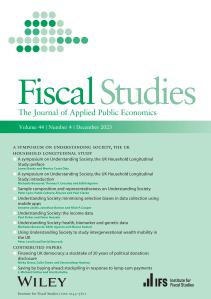Fuelled by changes to UK pensions policy over the last decade, most notably automatic enrolment into workplace pensions, an increasing number of people save for their retirement in defined contribution pension pots. Due to the end of compulsory annuitisation in 2015, known as ‘Pension Freedoms’, those saving in this way have a great deal of flexibility over the pace at which to withdraw income from their accumulated pension pot and how to vary this through their retirement.
These changes have led to concerns around what the appropriate withdrawal rate of pension pots should be for retirees. Desired profiles of spending in retirement are a key ingredient in how fast funds should be withdrawn. Whether people prefer a constant, increasing or decreasing profile of spending through their retirement will affect the kind of income profile they should aim for.
In this report, we shed light on this question by examining the spending patterns of current retirees in the UK using data from the Living Costs and Food Survey, from 2006 to 2018, which allows us to get a detailed picture of retired households’ spending patterns. We consider how spending changes with age and how it relates to levels of income and saving among retirees. We also document how spending on different categories of goods and services changes with age. Finally, we consider how spending patterns differ between different types of household.
Having documented these spending patterns, we consider their implications for current and future retirees in relation to ‘Pension Freedoms’, planning the drawdown of defined contribution pensions and the adequacy of the pension saving of current workers.
Key findings
- On average, retirees’ total household spending per person remains relatively constant in real terms through retirement, increasing slightly at ages up to around age 80 and remaining flat or falling thereafter. For example, for those born in 1939–43, spending at age 67 was on average £245 per person per week, rising to £263 per person per week at age 75, a real (in CPI-adjusted terms) increase of 7%, or just under 1% per year. For those born in 1924–28, spending fell from £197 per person per week at age 82 to £185 at age 88, a fall of 6%, or around 1% per year.
- By contrast, average household income per person for retirees aged 62 and older is more clearly increasing in real (CPI-adjusted) terms as people age. This is driven by private pension incomes increasing faster than the Consumer Prices Index (CPI) and by increasing numbers of people receiving the state pension and disability benefits as they age.
- In conjunction with relatively constant spending, increasing incomes mean that more people save, and save at higher rates, as they age. For example, for those born in 1939–43, almost six-in-ten (59%) saved at age 67 but this rose to almost seven-in-ten (69%) by age 75. Over the same ages, the share of income saved by that group rose from 2% to 15%.
- The composition of spending changes as people age, with per-person spending on food inside the home and on motoring falling steadily, spending on holidays increasing up to age 80 and then decreasing, and spending on household services (which includes spending on home help and domestic cleaning) and household bills increasing in later years of retirement.
- There are differences in spending patterns across different types of households. Households with above-average incomes for their age and birth cohort have an increasing profile of spending in their 60s and 70s (for example, increasing by 7% between ages 67 and 75 for the 1939–43 birth cohort), with spending falling slightly for those in their 80s. On the other hand, those with incomes below median have a slightly declining age profile of spending in their 60s (with the 1939–43 birth cohort seeing a fall of 1% between ages 67 and 75) and spending remains flat at older ages.
- These results suggest that, on average, in order to have an income profile that would match the age profile of spending through retirement seen among earlier cohorts, people should aim for a total income profile that is roughly constant in real (CPI-adjusted) terms through retirement. Given that policy is for the state pension to rise faster than prices over time, this suggests that, at least among current retirees, a declining profile of income from private sources might, on average, be appropriate – and particularly so for those with lower incomes, who are more reliant on the state pension in retirement. However, for those largely reliant on private pension income, a non-index-linked annuity would leave them more exposed to inflation and they may not be able to maintain the level of spending they would like in retirement.
- The death of one member of a couple will affect per-person spending of the surviving partner as many shared expenditures, such as housing costs, will not fall when a partner dies. When thinking about future spending needs, households thus need to consider how changes in circumstances, in particular the death of a partner, will affect income and spending in order to ensure that resources are available to fund increases in per-person spending. Future retirees, who are less likely to have occupational or state pensions with a survivor’s benefit, will have to decide how to take this into account when deciding speed of drawdowns and whether to buy an annuity that provides survivor’s benefits.
- If the spending patterns of current retirees are a good guide to how people in the future will want to spend, current savers might be best advised not to plan their retirement saving on the basis that their overall spending will fall sharply during retirement. Furthermore, we find that later-born generations spend more at the start of retirement on categories such as leisure services and holidays (which make up 7% of total spending at age 65 for the 1924–28 birth cohort compared with 11% for the 1944–48 birth cohort), which tend to increase with age, and less on categories such as food inside the home, which tend to decrease with age. This might mean that the spending of younger, and future, generations of retirees could grow more strongly with age than is the case for current retirees.












